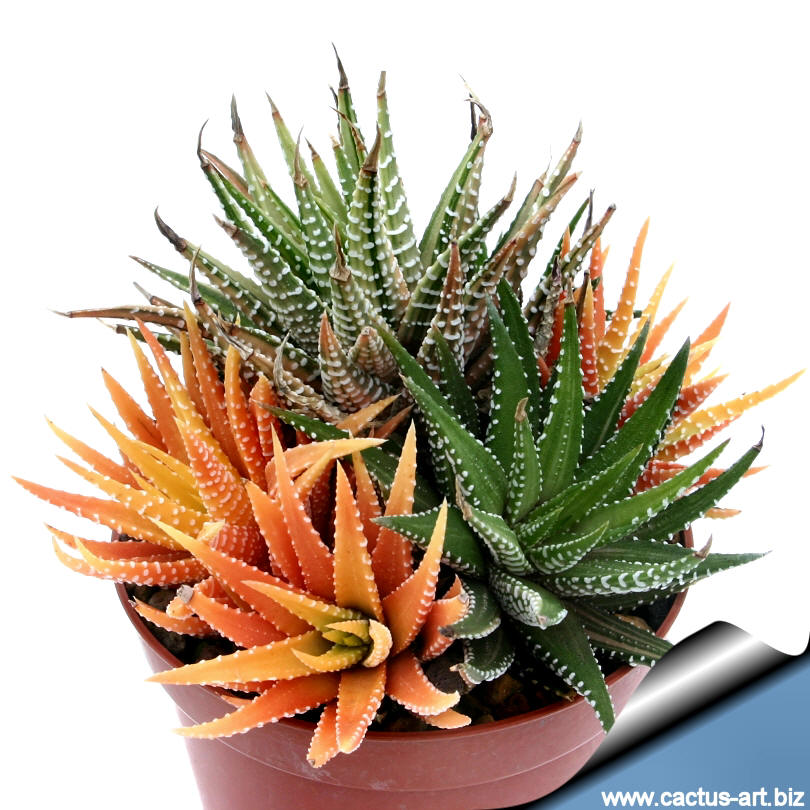|
|
|
 The
evergreen perennial dark green foliage is highlighted with silvery-white
vertical variegation. The
evergreen perennial dark green foliage is highlighted with silvery-white
vertical variegation.
It is highly variable and offsets profusely
with several colours and degree of variegation also in the same plant.
|
|
Description:
Stemless clustering perennial-succulent, with
evergreen perennial dark green, narrow foliage
that eventually form large clumps. There are several
variegated cultivars that differs from the standard species for
having silvery-white, yellow, pink or orange vertical
variegation. The more common variegated form (H.
attenuata "albovariegata") has cream to silvery white strips.
Rosettes: 6-12cm diameter, 6-13(25) cm tall, heavily clumping.
Leaves: Dark green, pointed and strikingly banded or spotted with
white with varying
amounts of variegation. Tubercles are
"patterned" on the upper surface of the leaves. The lower surface of the
leaves have transverse bands of tubercles
Flowers: White-greenish keels.
Bloom time: Can be ever blooming if you snip off each bloom when
it dies.
Photo of conspecific taxa, varieties, forms and cultivars of
Haworthia attenuata.
|
|
Advertising
|
|
|
|
Family:
Asphodelaceae (Aloacee - Liliaceae)
|
|
Scientific name:
Haworthia
attenuata (Haw.) Haw.
forma variegata
Origin:
Garden origin (Nursery
produced cultivar)
Common Names include: Variegated
Zebra plant
|
Synonyms:
-
Aloe attenuata
Haw. (Basionym)
-
Haworthia fasciata
(Willd.) Haw.
var. caespitosa
A.Berger
-
Haworthia pumila
ssp. attenuata
|
|
|
|
Cultivation: Very easy to grow and common. Need regular
water but do not water again until dry. Also, it is a species that is
dormant in the winter and require very little water (maybe even none)
during the cold months.
Frost Tolerance: Light frost protection
required. Minimum of 5ºC for safe growing (but hardy up to -5°C or
less.)
Sun Exposure: Requires light shade to bright light (protect
from strong
midday sun).
Can be sunburned if moved from shade/greenhouse into full sun. The
amount of sunlight it can withstand without scorching depends upon the
how hot it becomes in the summer in the locale in which it is planted.
It will have more colour if it receives more light. During the spring it
may be able to take full sun until the heat arrives at the end of
spring. In an area that has hot afternoon sun, it may be able to take
full morning sun, but requires afternoon shade or afternoon light shade.
Propagation: Seeds or (usually) offsets that appear at the
base between the
leaves; leave them
attached to form a cluster, or wait until they are 1/3 the size of the
parent and then detach and plant.
Remarks: Not all, but,
occasionally the variegated plants will
revert to solid colored foliage. Some varieties more than others but
most of them will revert. The plants that are
sports tend to be the worst. Sports are branches that spontaneous
changed to a variegated leaf. Because genetically the change is only
skin deep they can change back.
As you look at variegated plants you often see branches that have
reverted to solid green and others that have continued the change to
solid white, yellow or orange. The branches that have reverted green
tend to overtake the entire plant. If you think about it the reason is
obvious. Green means
chlorophyll. yellow or white means little to no chlorophyll. The
branches with lots of chlorophyll have more energy and grow more
vigorously.
If you have variegated plants that have green branches mixed in with the
variegated branches you need to cut ALL the green branches back to where
all the branches left go to variegated foliage. You need to be ruthless
about this. If some of the branches are all yellow or white you can cut
those back also, but because of their lack of chlorophyll they don't
tend to take over. The coloured shoots looks great but they are much
slower growing. More chlorophyll means more growth.

 |
|